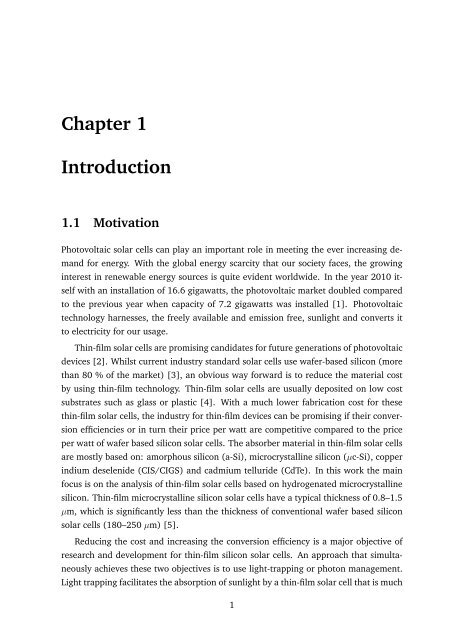Rahul Dewan - Jacobs University
Rahul Dewan - Jacobs University
Rahul Dewan - Jacobs University
Create successful ePaper yourself
Turn your PDF publications into a flip-book with our unique Google optimized e-Paper software.
Chapter 1<br />
Introduction<br />
1.1 Motivation<br />
Photovoltaic solar cells can play an important role in meeting the ever increasing demand<br />
for energy. With the global energy scarcity that our society faces, the growing<br />
interest in renewable energy sources is quite evident worldwide. In the year 2010 itself<br />
with an installation of 16.6 gigawatts, the photovoltaic market doubled compared<br />
to the previous year when capacity of 7.2 gigawatts was installed [1]. Photovoltaic<br />
technology harnesses, the freely available and emission free, sunlight and converts it<br />
to electricity for our usage.<br />
Thin-film solar cells are promising candidates for future generations of photovoltaic<br />
devices [2]. Whilst current industry standard solar cells use wafer-based silicon (more<br />
than 80 % of the market) [3], an obvious way forward is to reduce the material cost<br />
by using thin-film technology. Thin-film solar cells are usually deposited on low cost<br />
substrates such as glass or plastic [4]. With a much lower fabrication cost for these<br />
thin-film solar cells, the industry for thin-film devices can be promising if their conversion<br />
efficiencies or in turn their price per watt are competitive compared to the price<br />
per watt of wafer based silicon solar cells. The absorber material in thin-film solar cells<br />
are mostly based on: amorphous silicon (a-Si), microcrystalline silicon (µc-Si), copper<br />
indium deselenide (CIS/CIGS) and cadmium telluride (CdTe). In this work the main<br />
focus is on the analysis of thin-film solar cells based on hydrogenated microcrystalline<br />
silicon. Thin-film microcrystalline silicon solar cells have a typical thickness of 0.8–1.5<br />
µm, which is significantly less than the thickness of conventional wafer based silicon<br />
solar cells (180–250 µm) [5].<br />
Reducing the cost and increasing the conversion efficiency is a major objective of<br />
research and development for thin-film silicon solar cells. An approach that simultaneously<br />
achieves these two objectives is to use light-trapping or photon management.<br />
Light trapping facilitates the absorption of sunlight by a thin-film solar cell that is much<br />
1

















